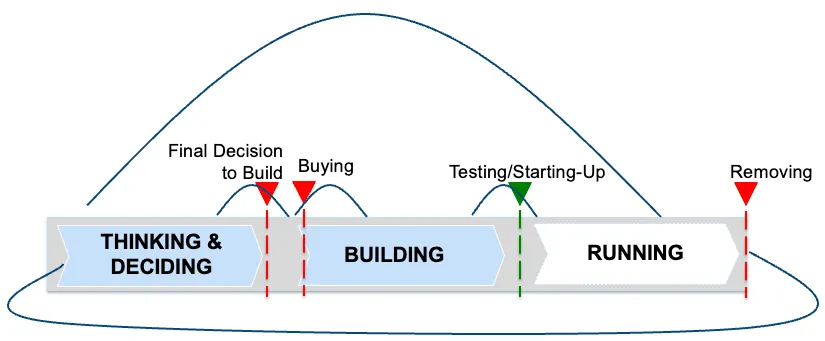Even the best-planned data center projects are vulnerable to a critical failure point – one that causes cascading delays, inefficiencies, and wasted resources.
The rapid expansion of the data center industry has exposed severe weaknesses in supply chain management. In the first blog in this series, we examined the sheer complexity of these supply chains, highlighting the vast network of stakeholders – from hyperscalers to contractors – who must work in sync to deliver these mission-critical facilities. In our second blog, we explored how supply chains are struggling to scale, with bottlenecks, procurement mismatches, and a lack of standardization leading to costly delays.
Of course, there are ways to overcome these problems. But even if these larger supply chain issues are addressed, one critical challenge remains: the breakdown at interfaces and handovers. No matter how well a project is planned, the reality is that most failures happen in the transitions – when responsibility shifts from one team to another. Whether it’s design to procurement, procurement to construction, or construction to operations, each handover represents an opportunity for miscommunication, inefficiency, and costly rework.
The result? Repeated delays, wasted resources, and a lack of continuous improvement. Let’s explore why handovers are the biggest failure point in data center construction, how the poor handovers and “catastrophic forgetting” keep projects from improving, and what can be done to fix it.
Why Handover Failures Are the Weakest Link
Even with the best supply chain strategies in place, data center projects consistently stumble at the transition points between teams. These handovers – when responsibility shifts from one stakeholder to another – are where delays, errors, and rework spiral out of control. This problem isn’t unique to data centers; it’s a well-documented issue in project learning theory.
In theory, every completed project should contribute to better efficiency and fewer errors in the next one. In reality, data suggests the opposite: rather than reducing error rates over time, projects are not improving – or in some cases, getting worse.
This fragments the knowledge transfer over the project timeline, meaning knowledge is lost and then rebuilt, over and over again, at every major project transition. So, instead of learning from past mistakes and refining processes, teams are repeatedly reinventing the wheel.
For example:
- From Design to Procurement: Long-lead items like power distribution units (PDUs) are often ordered before the design is finalized. When the equipment arrives, it doesn’t fit the final design, forcing teams to retrofit or rework the system.
- From Procurement to Construction: Procurement teams work on schedules that don’t align with on-site realities. Materials arrive too early and take up valuable storage space, or worse, they arrive too late, causing cascading delays.
- From Construction to Operations: Facility managers inherit a lack of documentation on what was installed, making future upgrades and maintenance more difficult.At each of these critical transitions, valuable information is lost, leading to costly delays, redundant work, and inconsistent execution.
Temporal Myopia: Why Projects Lose Sight of the Bigger Picture
Another major contributor to handover failures is what is known as temporal myopia learning across time – a phenomenon where decisions made at early project stages fail to account for future operational and technological realities.
This short-term focus leads to imperfect handovers, where teams prioritize immediate project constraints without considering long-term impacts. For example, a hyperscaler may specify a power configuration based on today’s AI workloads, but by the time the data center is commissioned, those workloads require an entirely different cooling and power distribution strategy.
By failing to connect decision-making across different phases, data center projects suffer from inconsistent learning, inefficient transitions, and costly last-minute adjustments.

Catastrophic Forgetting: A Persistent Learning Failure
In project learning theory, successful industries see a reduction in error rates and variance over time. As teams improve their processes, they make fewer mistakes, and outcomes become more predictable. However, in data center construction, this is not happening.
This breakdown in learning is referred to as “catastrophic forgetting”, a term borrowed from artificial intelligence research. In machine learning, catastrophic forgetting occurs when a system fails to retain past knowledge, meaning it must relearn the same lessons every time. The same happens in construction:
- Every new project faces the same sequencing challenges as previous ones.
- Lessons learned are not carried forward, meaning teams repeat the same mistakes.
- Instead of seeing a declining error curve, delays and cost overruns persist across projects.
This isn’t just an inconvenience – it’s a fundamental failure of the industry to improve efficiency over time.
Fixing Handovers with AI-Powered Coordination
Addressing handover failures in data center construction isn’t just about better planning – it requires real-time coordination, structured knowledge retention, and proactive risk management. Without a system that ensures smooth transitions across project phases, teams will continue to suffer from information loss, catastrophic forgetting, and the pitfalls of temporal myopia.
This is where Foresight’s AI-powered coordination tools provide a critical advantage. By synchronizing tasks, tracking dependencies, and capturing project knowledge, Foresight transforms handovers from a source of chaos into a strategic advantage.
Real-Time Task Coordination: Eliminating Sequencing Failures
Most handover failures stem from misaligned scheduling and dependencies. Traditional project controls rely on static schedules, but data center construction is too dynamic for static tools.
Foresight solves this by providing real-time task coordination, ensuring that teams work in sync, track dependencies, and adapt dynamically to changing conditions. With Kanban-style task tracking, teams can visualize exactly where each phase stands and adjust their schedules accordingly. When an issue arises, automated sequencing updates adjust timelines in real time, ensuring that delays in one area don’t create unnecessary bottlenecks in another. This system also improves cross-team visibility, allowing stakeholders to see potential risks before they escalate into costly disruptions.
Organizational Memory Retention: Stopping Knowledge Loss
One of the biggest contributors to handover failures is knowledge loss at each transition point, leading to teams relearning the same lessons project after project. In data center construction, past projects should provide valuable insights – yet, due to poor knowledge retention, teams keep facing the same delays, sequencing failures, and inefficiencies.
Foresight solves this by leveraging an organization’s historical project schedules to identify patterns and prevent recurring issues. Unlike traditional scheduling tools, which treat every project as a standalone effort, Foresight stores and analyzes past project data, recognizing trends such as:
- Which activities are consistently delayed across multiple projects and why?
- How long specific types of projects or activities take, rather than relying on initial estimates.
- Which handovers typically create bottlenecks, allowing teams to proactively adjust schedules to prevent slowdowns.
By continuously learning from an organization’s own project history, Foresight helps teams move beyond reactive problem-solving and instead apply past insights to improve future execution.
Live Risk Monitoring: Stopping Issues Before They Escalate
One of the biggest challenges in managing handovers is that issues are often identified too late. Without real-time visibility, teams only realize there’s a problem once a delay has already happened, by which point, remediation efforts are costly and disruptive. Instead of reacting to problems, Foresight enables teams to proactively identify and mitigate risks before they escalate.
Foresight’s live risk monitoring uses AI-driven analytics to track handover progress, flagging potential sequencing risks before they cause downstream delays. The system continuously monitors dependencies between teams, ensuring that work progresses in the correct sequence. If an issue is detected, such as a procurement delay that will impact installation, the platform sends an early warning alert, allowing teams to adjust their schedules or find alternative solutions before the problem grows. Additionally, Foresight provides scenario modeling, enabling teams to test different approaches to resolve scheduling conflicts and choose the most efficient path forward.
Closing the Gaps: Improving Communication and Execution in Data Center Construction
Handover failures are one of the biggest hidden risks in data center construction. Even with better supply chain planning and standardization, projects will continue to face costly delays if handover coordination remains broken.
By fixing handovers at their core, Foresight ensures that projects run more efficiently, teams retain knowledge across phases, and risks are proactively managed. With real-time task coordination, structured knowledge retention, and AI-powered risk monitoring, Foresight provides a modern solution to one of the most persistent challenges in data center construction.
Don’t let handover failures derail your data center projects. Schedule a call with our team to discover how Foresight’s AI-powered coordination can eliminate bottlenecks and keep your projects on track.


